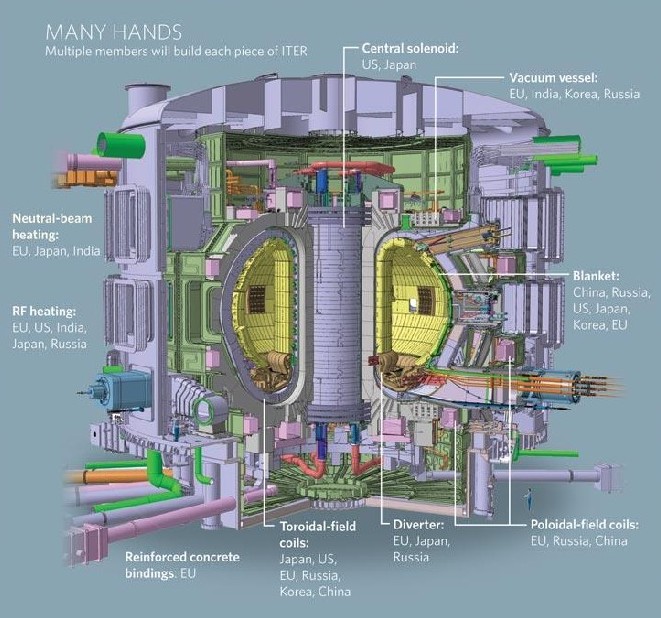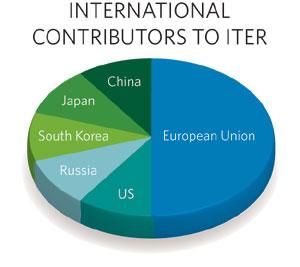| Published online 27 May 2009 | Nature 459, 488-489
(2009) | doi:10.1038/459488a
International partners are likely to scale
back the first version of the ITER reactor. Geoff Brumfiel reports.

A 180-hectare stretch of land has already been cleared for ITER.
St Paul-lez-Durance, France
ITER — a multi-billion-euro international experiment boldly aiming
to prove atomic fusion as a power source — will initially be far less ambitious
than physicists had hoped, Nature has learned.
Faced with ballooning costs and growing delays,
ITER's seven partners are likely to build only a skeletal version of the
device at first. The project's governing council said last June that the
machine should turn on in 2018; the stripped-down version could allow that
to happen (see Nature
453, 829; 2008). But the first experiments capable of validating fusion
for power would not come until the end of 2025, five years later than the
date set when the ITER agreement was signed in 2006.
The new scheme, known as 'Scenario 1' to ITER
insiders, will be discussed on 17–18 June in Mito, Japan, at a council
meeting that will include representatives from all seven members: the European
Union (EU), Japan, South Korea, Russia, the United States, China and India.
It is expected to be approved at a council meeting in November.
Indeed, the plan is perhaps the only way forward.
Construction costs are likely to double from the €5-billion (US$7-billion)
estimate provided by the project in 2006, as a result of rises in the price
of raw materials, gaps in the original design, and an unanticipated increase
in staffing to manage procurement. The cost of ITER's operations phase,
another €5 billion over 20 years, may also rise.
"Building ITER is like building the space
station, but having to set up NASA and ESA in the process."
In fact, the ultimate cost of ITER may never
be known. Because 90% of the project will be managed directly by individual
member states, the central organization has no way of gauging how much
is being spent, says Norbert Holtkamp, ITER's principal deputy director-general.
"They won't even tell us," he says. "And that's OK with me."
Holtkamp says that the only way to get ITER
built is to do the skeletal version first. Before scaling up to do energy-producing
experiments, he says, "you really need to know whether the major components
work. It's absolutely clear that this is the right approach." As to
why Scenario 1 is being touted only now, Holtkamp says it took him time
after joining the project to review the original schedule.
Fusion researchers say that Scenario 1 is
preferable to the alternative: a permanent smaller machine that would never
produce significant amounts of power. "You can't build a half ITER because
then you'll just go on and on not quite knowing what the answer is,"
says Steven Cowley, director of the UK Atomic Energy Authority's fusion
laboratory at Culham.
The project's rising price and lengthening
schedule have angered some of ITER's members, who plan to finalize the
schedule and budget by the end of this year. "People are pissed off,"
says a source close to the negotiations who requested anonymity because
of political sensitivity.

ITER is the most ambitious fusion experiment
ever proposed. At its heart is a doughnut-shaped device known as a tokamak
(see graphic), which uses magnetic fields to squeeze and heat hydrogen
isotopes to hundreds of millions of kelvins, until they fuse. The consequent
fusion reactions release high-energy neutrons that can, in principle, be
harnessed to generate electricity. Normal hydrogen will not generate enough
fusion events to produce large amounts of power, but when scientists inject
deuterium and radioactive tritium into the machine, it should generate
roughly 500 megawatts of thermal power — around 10 times the amount of
power needed to run it. Such an achievement would be long-sought proof
that fusion power can work, although a commercial reactor would still be
decades away.
The machine's costs have doubled once before.
Budgeted at US$6 billion in 1989, costs climbed to nearly twice that during
the decade that followed. Angered, the US Congress withdrew the country
from the project in 1999. The remaining partners — Europe, Russia and Japan
— pressed ahead to redesign the machine to keep it within $6 billion.
Design scaled back
The redesign fell to Robert Aymar, a prominent
French physicist who had overseen the French tokamak Tore Supra, in Cadarache.
Aymar redesigned the entire device in just three years with a staff of
70 — half the size of the original design team. In addition to shrinking
ITER to its present-day size, the team made other money-saving assumptions.
The new design did not include the cost for auxiliary equipment and some
spare parts, and it assumed that some buildings could be reused multiple
times. The design was accepted by ITER's partners in 2001 as a way to keep
within the $6-billion price tag, and used as a baseline when the United
States rejoined and India, South Korea and China joined the project.
|
suite:
Aymar maintains that his redesign was never
meant as a final blueprint for the machine, but to act as a guideline for
ITER's members to decide who would contribute which portion. It did not
assign costs to the values of various components, but used 'ITER units
of account' to allow nations to negotiate which parts they would provide
as their share. "What we provided was not a cost," he says. "We
provided a value."
Some ITER partners say Aymar's design contained
an appropriate level of detail. "It was a conceptual design," says
Octavi Quintana Trias, director for energy at the European nuclear research
organization Euratom, and an EU representative on the ITER council. "You
will not develop and refine the design until you have a real commitment
to go ahead."
But some US officials see things differently.
"We thought that it was 80% designed and that you only had 20% to fill
in, and it turned out to be more like 40%," says Raymond Orbach, former
head of science at the US Department of Energy and until this year a US
representative on the ITER council.
When the project was approved in 2006, the
newly formed ITER organization set to work reviewing and completing Aymar's
2001 design, adding parts that included a set of superconducting magnets
to control a type of instability not anticipated in the earlier design.
The adjustments have cost time and money.

Agencies in the seven member governments are
also struggling to set up the complex network that will eventually supply
ITER with parts. Although the specifications for each piece can be set
by the central lab, it is individual governments that will award contracts
to industry and oversee production.
Who provides what is detailed through a series
of procurement agreements, which have been slow in coming: 26 were originally
scheduled to be ready by the end of 2008, but as of late May this year,
only 17 had been signed. The delay is in part due to setting up domestic
organizations that will award the contracts, says Niek Lopes Cardozo, vice-chairman
of Fusion for Energy, the Barcelona-based body overseeing contracts to
European industry. "Building ITER is like building the space station,
but having to set up NASA and ESA [the European Space Agency] in the process."
During negotiations, each nation bargained
for a stake in the most technically sophisticated parts of the machine,
and, as a result, single components will be built with parts from several
nations. For example, the 150,000 kilometres of superconducting wire for
the magnetic coils will be produced in China, Japan, Russia, Korea, the
EU and the United States.
Awarding contracts, setting up production
lines and ensuring quality control across the seven partners will also
require significantly more manpower than anticipated in 2001, when there
were only three member states. Holtkamp says that the central project office
will need up to 750 staff to do the job — a 25% increase over the original
plan.
Nations could bring down the cost of the machine
by swapping procurement agreements and consolidating production, but that's
not politically realistic, says Kaname Ikeda, ITER's director-general.
"The first objective is [for members] to get the experience of designing,
fabricating and operating this machine," he says. Akeda adds that most
seem willing to live with the cost increase, so long as they gain the knowledge
needed to build a power-producing fusion reactor.
Member governments are preparing to shoulder
the increase. Last year, the United States upped the estimated cost of
its contribution to $2.2 billion — double the preliminary price.
The EU, meanwhile, is grappling with increased
spending to complete the buildings for the project. We are "trying to
get rid of everything that is not indispensable," says Trias. "Each
country has its own internal problems," adds Evgeny Velikhov, a Russian
representative on the ITER council, although he adds that "Russia does
not see any problem in fulfilling its obligation".
Those close to the project now see Scenario
1 as the only practical way forward. Under the plan, the reactor would
initially be built without several crucial and expensive components, including
an inner shielding wall and test bed for new materials such as lithium
blankets that generate tritium for the machine, along with the diverter,
a series of tiles at the bottom of the tokamak that shunts heat safely
out of the device. Also gone will be expensive accelerators to pump neutral
beams of fuel into the machine, and some radio-frequency devices designed
to further heat the plasma. Without these components, ITER can handle only
plasmas of hydrogen, not deuterium or tritium.
The plan would allow scientists and engineers
to ensure that ITER works long before it is injected with tritium — a process
that will make large sections of the machine inaccessible.
"They want to see success at the end, and
the way to success is this road," says Holtkamp. "There really is
no other one." |
 NUCLEAIRES !
NUCLEAIRES ! NUCLEAIRES !
NUCLEAIRES !